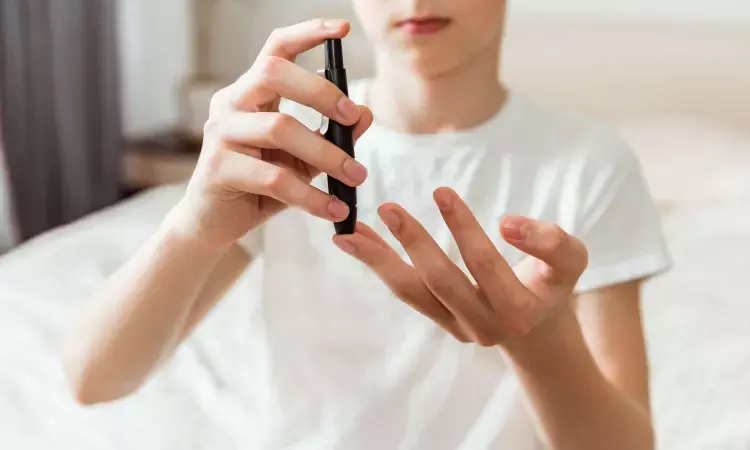- Home
- Medical news & Guidelines
- Anesthesiology
- Cardiology and CTVS
- Critical Care
- Dentistry
- Dermatology
- Diabetes and Endocrinology
- ENT
- Gastroenterology
- Medicine
- Nephrology
- Neurology
- Obstretics-Gynaecology
- Oncology
- Ophthalmology
- Orthopaedics
- Pediatrics-Neonatology
- Psychiatry
- Pulmonology
- Radiology
- Surgery
- Urology
- Laboratory Medicine
- Diet
- Nursing
- Paramedical
- Physiotherapy
- Health news
- Fact Check
- Bone Health Fact Check
- Brain Health Fact Check
- Cancer Related Fact Check
- Child Care Fact Check
- Dental and oral health fact check
- Diabetes and metabolic health fact check
- Diet and Nutrition Fact Check
- Eye and ENT Care Fact Check
- Fitness fact check
- Gut health fact check
- Heart health fact check
- Kidney health fact check
- Medical education fact check
- Men's health fact check
- Respiratory fact check
- Skin and hair care fact check
- Vaccine and Immunization fact check
- Women's health fact check
- AYUSH
- State News
- Andaman and Nicobar Islands
- Andhra Pradesh
- Arunachal Pradesh
- Assam
- Bihar
- Chandigarh
- Chattisgarh
- Dadra and Nagar Haveli
- Daman and Diu
- Delhi
- Goa
- Gujarat
- Haryana
- Himachal Pradesh
- Jammu & Kashmir
- Jharkhand
- Karnataka
- Kerala
- Ladakh
- Lakshadweep
- Madhya Pradesh
- Maharashtra
- Manipur
- Meghalaya
- Mizoram
- Nagaland
- Odisha
- Puducherry
- Punjab
- Rajasthan
- Sikkim
- Tamil Nadu
- Telangana
- Tripura
- Uttar Pradesh
- Uttrakhand
- West Bengal
- Medical Education
- Industry
Plasma growth hormone mediators associated with poor blood sugar control in youth with type 2 diabetes

USA: A recent study has shed light on the associations of growth hormone (GH) mediators (e.g., growth hormone receptor (GHR), insulin-like growth factor 1 (IGF-1), insulin-like growth factor binding protein 1 (IGFBP-1)) with loss of glycemic control in youth with type 2 diabetes (T2D).
The researchers found that plasma levels of these three proteins involved in GH activity showed significant links to the controllability of T2D in adolescents.
The findings, presented at the American Diabetes Association 83rd Scientific Sessions and subsequently published in the Diabetes journal, suggest that these proteins may serve as risk markers for incident type 2 diabetes and help identify youth who could benefit from aggressive preventive care.
Type 2 diabetes in youth is known to have a more severe phenotype than in adults, and puberty is a potential contributor to this difference. It is suggested that pubertal changes in growth hormone mediators may impact beta cell function and insulin sensitivity.
Chang Lu, a pediatric endocrinologist at Joslin and at Boston’s Children’s Hospital, and colleagues examined associations of GH mediators with loss of glycemic control in youth with type 2 diabetes using the Treatment Options for Type 2 Diabetes in Adolescents and Youth (TODAY) cohort (N= 310).
For this purpose, the researchers performed a paired comparison of plasma concentrations of GHR, IGF-1, and IGFBP-1 (ELISA) between 0 and 36 months based on the TODAY primary outcomes of glycemic control loss versus maintained glycemic control (LGC vs MGC). Loss of glycemic control was defined as HbA1c ≥ 8% for 6 months and/or insulin dependence.
The researchers studied associations of growth hormone mediators with insulinogenic index, HbA1c, 1/fasting insulin, and oral disposition index. Models were adjusted for sex, age, race, baseline HbA1c, and treatment arm.
The study revealed the following findings:
- Mean plasma IGF-1 (ng/mL) was lower in the LGC group at 0mo (LGC: 451 ± 141, MGC: 485 ± 155), and at 36mo (LGC: 340 ± 117, MGC: 400 ± 136).
- Increase in IGF-1 between 0-36mo predicted lower HbA1c at 36mo (B = -3.2E-3, SE = 9.0E-4).
- Higher GHR was associated with higher HbA1c (B = 1.2E-2, SE = 3.0E-3) and lower 1/fasting insulin (B = -6.6E-4, SE = 2.1E-4) at 0mo. Increase in GHR between 0-36mo predicted higher 36mo HbA1c (B = 3.0E-2, SE = 9.4E-3).
- IGFBP-1 was positively associated with 1/fasting insulin at 0m (B = 1.1E-3, SE = 4.9E-4).
- In exploratory analyses stratified by Tanner stage (TS) at study entry, GH mediators changed differentially between TS 1-3 (n = 31) versus TS 4-5 (n = 274).
"There was a difference in growth hormone mediators based on primary outcome in TODAY, and were associated with insulin sensitivity and HbA1c," the researchers wrote.
"Whether changes in GH mediators contribute to, or are the result of, changes in glucose metabolism needs to be determined in future studies," they concluded.
Reference:
CHANG LU, DANIELLE WOLFS, LAURE EL GHORMLI, LORI M. LAFFEL, MARY-ELIZABETH PATTI, ELVIRA M. ISGANAITIS; 134-OR: Associations of Growth Hormone (GH) Mediators with Loss of Glycemic Control in Youth with Type 2 Diabetes (T2D). Diabetes 20 June 2023; 72 (Supplement_1): 134–OR. https://doi.org/10.2337/db23-134-OR
Dr Kamal Kant Kohli-MBBS, DTCD- a chest specialist with more than 30 years of practice and a flair for writing clinical articles, Dr Kamal Kant Kohli joined Medical Dialogues as a Chief Editor of Medical News. Besides writing articles, as an editor, he proofreads and verifies all the medical content published on Medical Dialogues including those coming from journals, studies,medical conferences,guidelines etc. Email: drkohli@medicaldialogues.in. Contact no. 011-43720751


